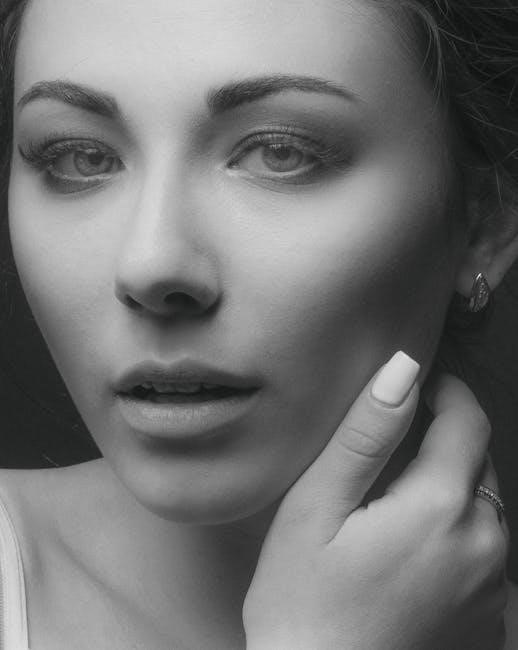classic lash mapping guides

Classic lash mapping is a foundational technique for creating stunning eyelash extensions. It involves planning lash lengths, curls, and thicknesses to enhance natural beauty and achieve desired styles. This method ensures symmetry and customization, making it ideal for both professionals and beginners in lash artistry.
What is Classic Lash Mapping?
Classic lash mapping is a technique used to plan and design eyelash extensions by mapping lash lengths, curls, and thicknesses across the eye. It ensures a balanced, customized look tailored to the client’s eye shape and natural lash growth. This method helps achieve the desired style, whether natural or dramatic, by strategically placing lashes to enhance the eye’s features. Proper mapping ensures symmetry and prevents common mistakes like uneven application or inappropriate lash placement.
Importance of Lash Mapping in Eyelash Extensions
Lash mapping is crucial for achieving desired results in eyelash extensions. It ensures a balanced, symmetrical look by strategically placing lashes to complement the client’s eye shape and natural lash growth. Proper mapping prevents common mistakes like uneven application or inappropriate lash placement, enhancing the overall aesthetic. It also allows technicians to customize styles, ensuring the extensions suit the client’s preferences and facial features. Effective lash mapping elevates the quality of the service, making it a cornerstone of professional lash artistry.

Understanding Eye Shapes and Their Characteristics
Eye shapes, such as almond, round, hooded, monolid, upturned, and downturned, vary in structure and lash line visibility, influencing lash mapping techniques for balanced, customized looks.
Almond Eyes
Almond eyes are a common and versatile shape, characterized by slightly covered top and bottom iris edges. They suit various lash styles, including cat-eye and round lashes. The classic cat-eye elongates the outer corners, while round lashes soften the look. This shape allows for balanced lash mapping, enhancing natural beauty without dramatic changes. Proper lash length and curl selection are key to complementing almond eyes, ensuring a harmonious and flattering result.
Round Eyes
Round eyes are characterized by visible irises with no lid coverage, creating an open and bright appearance. To complement this shape, classic lash mapping often involves longer lashes at the outer corners to elongate the eye. This technique helps balance the roundness, creating a more oval-like appearance. The lashes should gradually increase in length from the inner to outer corners, avoiding excessive volume to maintain a natural look. This approach enhances the eye’s openness while adding subtle drama, making round eyes appear more balanced and defined.
Hooded Eyes
Hooded eyes feature a heavy brow bone with a deep-set crease, often hiding the lash line under the lid. To enhance this shape, classic lash mapping focuses on creating the illusion of more open space. Shorter to medium-length lashes are recommended, with a subtle gradient in length from the inner to outer corners. Avoiding excessive volume prevents the eyes from appearing overwhelmed. Instead, opt for lighter lashes that add definition without bulk. This approach ensures the lashes complement the eye’s natural structure, creating a balanced and lifted appearance while maintaining a natural look.
Monolid Eyes
Monolid eyes, common in Asian women, feature a less apparent crease, giving the eyes a smooth, flat appearance. The lashes are often hidden under the lid, making them less visible. To enhance monolid eyes with classic lash mapping, focus on creating a subtle, natural look. Use medium-length lashes to avoid overwhelming the eye, and opt for a light to medium volume. A natural or cat-eye style can add definition without looking too heavy. Proper lash mapping ensures the lashes are visible and complement the eye’s structure, enhancing their natural beauty while maintaining a soft, elegant appearance.

Upturned and Downturned Eyes
Upturned eyes have outer corners that tilt upward, creating an exotic, lifted appearance, while downturned eyes feature lower outer corners. For upturned eyes, classic lash mapping can enhance their natural lift by placing longer lashes on the outer corners. For downturned eyes, shorter lashes in the center and longer ones on the outer corners can create balance and prevent a “sad” look. Proper lash mapping ensures the extensions complement the eye’s natural shape, avoiding styles that may exaggerate downturned eyes or overpower upturned ones, resulting in a harmonious and flattering lash design tailored to each eye type.

Eye Spacing and Alignment
Eye spacing and alignment play a crucial role in classic lash mapping. Close-set eyes benefit from longer lashes on the outer corners to create the illusion of more space, while wide-set eyes can balance with shorter lashes in the center. Proper alignment ensures symmetry, avoiding styles that make eyes appear uneven. Techniques like elongating the lash line or adjusting lash lengths help enhance the natural spacing and alignment, ensuring a balanced and harmonious look tailored to each client’s unique eye structure and facial features for a flawless finish.
Natural Lash Assessment
Natural lash assessment evaluates growth direction, strength, and health to determine suitable extension lengths and curls. This step ensures extensions complement the client’s lashes without causing damage.
Growth Direction of Natural Lashes
The growth direction of natural lashes varies among individuals, ranging from straight to curly or downward-pointing. Assessing this direction is crucial for selecting the right curl and angle of extensions. For instance, lashes growing downward may require a different approach than those growing outward. Understanding the natural growth pattern ensures extensions blend seamlessly, enhancing the client’s eye shape and maintaining a natural look. This step is vital for creating a balanced and aesthetically pleasing lash design tailored to each client’s unique features.
Strength and Health of Natural Lashes
Evaluating the strength and health of natural lashes is critical for determining suitable extension lengths and thicknesses. Weak or delicate lashes cannot support heavy or long extensions, risking damage. Assessing lash health helps in selecting appropriate weights and styles, ensuring extensions complement the client’s natural lashes without causing harm. This step is essential for creating a durable and visually appealing lash design while maintaining the integrity of the client’s natural lashes. Proper evaluation ensures a safe and effective application process tailored to individual lash conditions.

Popular Classic Lash Mapping Styles
Classic lash mapping includes Natural, Cat Eye, Doll Eye, and Open Eye styles, each offering unique looks tailored to different eye shapes and client preferences.
Natural Lash Mapping
Natural lash mapping mimics the client’s natural lash growth, creating a subtle, effortless look. It involves gradual transitions in lash length and thickness, avoiding dramatic changes. This style enhances the eye’s natural shape without overpowering it. Ideal for everyday wear, natural lash mapping suits all eye shapes, including almond, round, and hooded eyes. It focuses on blending extensions seamlessly with natural lashes, ensuring comfort and a soft appearance. This technique is perfect for clients seeking a low-maintenance, understated beauty boost while preserving the health of their natural lashes.

Cat Eye Lash Mapping
Cat Eye Lash Mapping is a popular technique that elongates the outer corners of the eyes, creating a winged, dramatic effect. This style is ideal for clients with round, close-set, or downturned eyes, as it lifts and accentuates the eyes. The lashes are longest at the outer corners, gradually decreasing in length toward the inner eye. This creates a sleek, glamorous look that adds depth and dimension. The Cat Eye style is perfect for those seeking a bold, eye-catching appearance while maintaining balance with their natural eye shape and facial features.
Doll Eye Lash Mapping
Doll Eye Lash Mapping creates a wide-eyed, innocent look by focusing on longer lashes in the center of the eye. This style emphasizes the middle lashes, with lengths gradually decreasing toward the outer corners. It enhances the natural shape of almond eyes while creating a soft, rounded effect. The Doll Eye style is versatile and suits most eye shapes, making it a popular choice for clients seeking a youthful, elegant appearance. This technique balances drama and subtlety, offering a timeless look that complements various facial features and personal styles.
Open Eye Lash Mapping
Open Eye Lash Mapping is designed to create a more open and awake appearance. This style focuses on placing longer lashes in the center of the eye, with shorter lashes toward the corners. It enhances the natural shape of the eye while making it appear larger and more defined. Ideal for hooded or monolid eyes, this technique balances lash lengths to avoid overwhelming the eye. The result is a fresh, natural look that complements the client’s features without appearing overly dramatic, making it a versatile choice for everyday wear or subtle elegance.
Customizing Lash Maps

Customizing lash maps involves tailoring lash length, curl, and volume to complement individual eye shapes and natural lash growth, ensuring a personalized and flattering look for each client.
Adjusting Lash Length for Different Eye Shapes
Adjusting lash length is crucial for complementing various eye shapes. For almond eyes, a natural gradient with longer lashes in the center creates balance. Round eyes benefit from longer lashes on the outer corners to elongate. Hooded eyes require shorter lashes to avoid heaviness, while monolid eyes may need a subtle, natural approach. Upturned eyes can handle longer lashes for a dramatic look, and downturned eyes benefit from shorter lashes on the outer corners to lift. Properly adjusting lash length enhances the client’s natural features while maintaining lash health and balance.
Choosing the Right Curl for Your Client
Choosing the right curl for your client is essential for achieving a natural and flattering look. Assess the natural direction of their lashes to determine the best curl. Downward-growing lashes may require a gentler curl, while straight lashes can handle more dramatic options. Consider the client’s eye shape and desired drama level. Common curls include C, D, and L, with D being the most popular for its versatility. Finer lashes may not support heavier curls, so prioritize lash health. Balancing the client’s preferences with their natural features ensures a stunning, personalized result that enhances their eye shape and lash line.

Thickness and Volume in Classic Lash Mapping
Thickness and volume in classic lash mapping are crucial for creating a balanced and dramatic look. Assess the client’s natural lash strength to determine the appropriate thickness, ensuring extensions don’t damage their lashes. Volume is achieved by layering lashes, with more emphasis on the outer corners for a balanced effect. This technique enhances eye shape, making round eyes appear more elongated. Using the right tools and adhesives ensures a seamless application. While volume adds drama, it should still look natural, complementing the client’s features without overwhelming them. Properly executed, it elevates the lash line for a stunning, personalized result.
Common Mistakes to Avoid in Lash Mapping
Common mistakes include using uniform lash length across the eye and ignoring natural lash growth direction. These errors can lead to an unbalanced, unnatural look.
Using Uniform Lash Length Across the Eye
Using uniform lash length across the eye is a common mistake that can result in an unnatural, unbalanced look. This approach fails to consider the client’s eye shape, natural lash growth direction, and desired aesthetic. For instance, applying the same length to all lashes can make almond eyes appear less defined, round eyes overly exaggerated, or hooded eyes disproportionately heavy. It also ignores the opportunity to create depth or emphasis through gradual length transitions. Avoiding this mistake ensures a more tailored, visually pleasing lash design that complements the client’s features.
Not Considering the Client’s Natural Lash Growth
Ignoring the client’s natural lash growth direction and strength is a critical error in classic lash mapping. This oversight can lead to extensions that appear unnatural or cause damage. Assessing the lash growth direction helps determine the appropriate curl and placement, ensuring extensions complement the client’s features. Additionally, evaluating lash strength is crucial for selecting suitable lengths and thicknesses. Failing to consider these factors can result in extensions that look mismatched or cause discomfort. Proper assessment ensures a seamless, personalized look that enhances the client’s natural beauty while maintaining lash health. This step is vital for achieving long-lasting, flattering results.

Tools and Resources for Lash Mapping
Physical lash mapping charts and digital guides are essential tools for creating precise lash maps. These resources help artists visualize and customize lash styles for various eye shapes and preferences, ensuring professional results.

Physical Lash Mapping Charts
Physical lash mapping charts are durable, waterproof tools designed for precision. Printed on laminated cardstock, they provide clear guides for classic, hybrid, and volume lash styles. These charts often feature front and back designs, making them versatile for practice and application. Tools like the LEES A.M. Practice Lash Sponge complement these charts, helping artists master lash placement. Physical charts are ideal for beginners, offering a hands-on approach to understanding lash mapping techniques and ensuring consistent, professional results for various eye shapes and client preferences.
Digital Lash Mapping Guides and Apps
Digital lash mapping guides and apps offer innovative solutions for lash artists, providing step-by-step tutorials and customizable templates. These tools allow for virtual lash try-ons, helping to visualize styles like cat eye or doll eye. Many apps include features for eye shape analysis and lash length recommendations, ensuring personalized results. Digital guides are accessible on mobile devices, making them convenient for practice and client consultations. They also offer interactive learning, perfect for mastering classic lash mapping techniques and staying updated on industry trends. These resources enhance creativity and precision, benefiting both professionals and beginners in lash artistry.
Step-by-Step Lash Mapping Process
The process begins with a consultation to understand the client’s preferences. Next, assess eye shape and natural lash growth. Create a detailed lash map, then apply extensions carefully, ensuring symmetry and style alignment.
Consultation and Client Assessment
A thorough consultation is the first step in classic lash mapping. Discuss the client’s preferences, lifestyle, and desired outcome. Assess their eye shape, natural lash growth direction, and strength to determine suitable lengths and curls. Evaluate the health of their lashes to ensure extensions won’t cause damage. Measure natural lash length and strength to guide extension selection. This step ensures a personalized lash map that complements the client’s features and achieves their desired look while maintaining lash health and integrity.
Creating the Lash Map
Creating a lash map involves strategically planning the placement of lash extensions. Start by dividing the eye into sections, such as inner, middle, and outer corners. Determine the appropriate lengths, curls, and thicknesses for each section based on the client’s eye shape and preferences. Use a lash mapping chart or guide to visualize the design. Ensure a gradual transition between lengths for a natural look. This step requires precision to achieve balance and symmetry, ensuring the final result enhances the client’s natural beauty and meets their expectations.
Applying the Lash Extensions
Applying lash extensions requires precision and care. Start by isolating natural lashes using tweezers, ensuring no lashes are stuck together. Apply a thin layer of adhesive to the extension and attach it 1mm away from the natural lash base. Follow the lash map to place extensions in the planned sections, starting from the inner corner and moving outward. Use a light touch to avoid excess adhesive. After application, gently press the extensions against the natural lashes to secure them. Allow the adhesive to dry completely before finishing touches. Proper isolation and placement are key to a flawless, long-lasting result.
The Future of Lash Mapping
The future of lash mapping lies in advancements like digital tools and personalized techniques, driving innovation and industry trends for more precise, tailored lash extension applications.
Advancements in Lash Mapping Techniques
Advancements in lash mapping techniques are revolutionizing the industry, with digital tools and AI-driven apps enabling precise, customized designs. These innovations allow for real-time simulations, ensuring perfect symmetry and adaptation to individual eye shapes. Hybrid and volume mapping techniques are gaining popularity, offering greater versatility. Professionals can now achieve more intricate styles with ease, while maintaining natural-looking results. These advancements not only enhance creativity but also improve efficiency, making lash mapping more accessible and consistent for artists of all skill levels.
Industry Trends and Innovations
The lash industry is evolving rapidly, with trends shifting toward personalized and sustainable solutions. Digital lash mapping tools and AI-powered apps are becoming popular, offering precise customization and real-time simulations. Hybrid and volume techniques are gaining traction, blending classic styles with modern twists. Eco-friendly products and cruelty-free adhesives are also in demand, aligning with consumer preferences for ethical beauty. These innovations are reshaping how artists create lash extensions, making the process more efficient and client-centric. As technology advances, the future of lash mapping promises even greater creativity and precision.
Leave a Reply
You must be logged in to post a comment.